Episodes
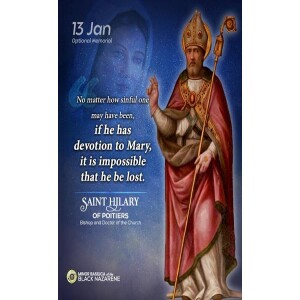
Saturday Jan 13, 2024
Saturday Jan 13, 2024
Stand In The Gap With Us And Saint Hilary of Poitiers 1/13/2024
Beloved, being very eager to write to you of our common salvation,
I found it necessary to write appealing to you to contend for the faith which was once for all delivered to the saints." St. Jude St. Hilary was born at Poitiers, in modern day western France around 310 A.D. Much of the Roman world at the time was Pagan and Hilary was raised by Pagan Parents who ensured the best education becoming a Greek Scholar.
Hilary would be about 15 years old when the great Council of Nicea (325 A.D.) took place that officially condemned the teaching of the Heretic Arius of Alexandria Egypt which denied the divinity of Jesus.
This would eventually become very important to Hilary. Hilary's interest in philosophy kept him searching for truth, as a Pagan, he was much like the people whom St. Paul preached to at the Areopagus in Greece: St. Paul said: "Men of Athens, I perceive that in every way you are very religious. For as I passed along, and observed the objects of your worship, I found also an altar with this inscription, 'To an unknown god.' What therefore you worship as unknown, this I proclaim to you.
The God who made the world and everything in it, being Lord of heaven and earth, does not live in shrines made by man, nor is he served by human hands, as though he needed anything, since he himself gives to all men life and breath and everything." Acts 17:22-25 Hilary would forsake his Platonic background once he had been exposed to the Catholic Faith. He began searching the Scriptures and upon his reading of Moses at the burning bush was captivated on who the real God truly is.
"God said to Moses, "I AM WHO AM." And he said, "Say this to the people of Israel, 'I AM has sent me to you" (Exodus 3:14).
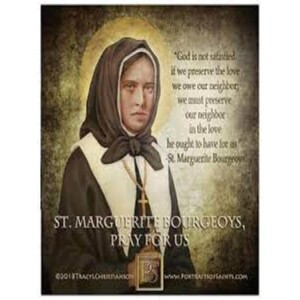
Friday Jan 12, 2024
Friday Jan 12, 2024
Stand In The Gap With Us And Saint Marguerite Bourgeoy 1/12/2024
We know that the historical Marguerite de Thibouville was the heiress of a venerable noble family of Normandy, was probably young when she became Carrouges' second wife, and was, after the fact, enriched by her husband's fame and fortune in his role as celebrated hero of the “last duel.” She had at least three children
“God closes a door and then opens a window,” people sometimes say when dealing with their own disappointment or someone else’s. That was certainly true in Marguerite’s case.
Besides chaperoning girls sent from France as brides for settlers (Filles du Roi), she recruited French and Canadian girls as teachers, organized a boarding school for girls in Montréal, a school for Indigenous girls on the Sulpician reserve of La Montagne, and a domestic arts school.
With the first settlers she shared the dangers and hardships, as well as the efforts and hopes that marked life in the early colony. Like them, she was vulnerable to the threats posed by the environment the enemy, and disease, as well as by sometimes hostile or incompetent authorities in both church and state. She consistently avoided and, whenever possible, refused all preferment or privilege that would remove her from the lot of ordinary people in New France, the poor and struggling settlers attempting to build a better life for themselves and their families in the New World.
Children from European as well as Native American backgrounds in 17th-century Canada benefited from her great zeal and unshakable trust in God’s providence.
Born the sixth of 12 children in Troyes, France, Marguerite at the age of 20 believed that she was called to religious life.

Thursday Jan 11, 2024
Thursday Jan 11, 2024
Stand In The Gap With Us And Blessed William Carter 1/11/2024
William Carter was born in London in 1548, the son of John Carter, a draper, and Agnes, his wife.
Born in London, William Carter entered the printing business at an early age. For many years he served as apprentice to well-known Catholic printers, one of whom served a prison sentence for persisting in the Catholic faith.
William Carter, a married bookseller, established his own printing press in London to publish Catholic literature for England's persecuted Catholic population.
William himself served time in prison following his arrest for “printing lewd [i.e., Catholic] pamphlets” as well as possessing books upholding Catholicism.
In December 1579 he was committed the Gatehouse "for not conforming himself in matters of religion"
William himself served time in prison following his arrest for “printing Catholic pamphlets” as well as possessing books upholding Catholicism. But even more, he offended public officials by publishing works that aimed to keep Catholics firm in their faith.
But even more, he offended public officials by publishing works that aimed to keep Catholics firm in their faith. Officials who searched his house found various vestments and suspect books, and even managed to extract information from William’s distraught wife. Over the next 18 months, William remained in prison, suffering torture and learning of his wife’s death.
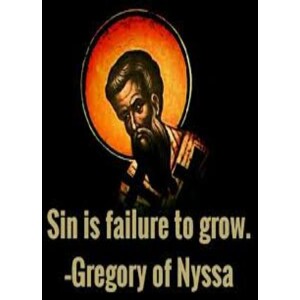
Wednesday Jan 10, 2024
Wednesday Jan 10, 2024
Stand In The Gap With Us And saint Gregory of Nyssa 1/10/2024
Gregory was born around 335, His family was aristocratic and Christian his mother was Emmelia of Caesarea, and his father, a rhetorician, has been identified either as Basil the Elder or as a Gregory. Among his eight siblings were St. Macrina the Younger, St. Naucratius, St. Peter of Sebaste and St. Basil of Caesarea
Gregory's parents had suffered persecution for their faith: he writes that they "had their goods confiscated for confessing Christ."
Gregory participated in the First Council of Constaantinople (381), Gregory, following Basil, defined the Trinity as "one essence in three persons ", the formula adopted by the Council of Constantinople in 381.
was Bishop of Nyssa in Cappadocia from 372 to 376 and from 378 until his death in 395.
philosophical theologian and mystic, leader of the orthodox party in the 4th-century Christian controversies over the doctrine of the Trinity. Primarily a scholar, he wrote many theological, mystical, and monastic works in which he balanced Platonic and Christian traditions.
Gregory was among the early Christian voices to write against slavery, declaring the institution inherently sinful.
The fundamental fact about human nature according to Gregory of Nyssa is that humans were created in the image of God. This means that because in God a transcendent nature exists which projects energies out into the world, we would expect the same structural relation to exist among human beings vis-a-vis their bodies.
The son of two saints, Basil and Emmilia, young Gregory was raised by his older brother, Saint Basil the Great, and his sister, Macrina, in modern-day Turkey.
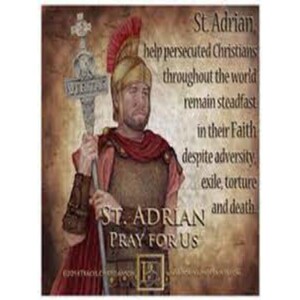
Tuesday Jan 09, 2024
Tuesday Jan 09, 2024
Stand In The Gap With Us And Saint Adrian of Canterbury 1/9/2024
Adrian became a valuable advisor to the pontiff and, three years later, was offered the position of Archbishop of Canterbury. He declined the papal appointment, but was persuaded to accompany Theodore to England as a trusted counselor.
Pope St. Vitalian judged him to be the best person to fill the vacant post of Archbishop of Canterbury, for his talents were most suitable for instructing and nurturing a nation still young in the Faith.
But St. Adrian, deeming himself unworthy, suggested St. Theodore of Tarsus in his place. The Pope agreed but sent him along to be the assistant and adviser of the Archbishop.
Though Saint Adrian turned down a papal request to become Archbishop of Canterbury, England, Pope Saint Vitalian accepted the rejection on the condition that Adrian serve as the Holy Father’s assistant and adviser. Adrian accepted, but ended up spending most of his life and doing most of his work in Canterbury.
the Pope to appoint Theodore, a Greek monk, in his place. The Pope yielded, on condition that Adrian should accompany Theodore to England and be his adviser in the administration of the Diocese of Canterbury.
Setting out in 668, the two holy men proceeding by way of France. There, St. Adrian was arrested by Ebroin, Mayor of Neustria, as an agent of the Eastern Emperor; and St. Theodore alone was able to go on. When St. Adrian was finally able to reach England, he found St. Theodore already confirmed in his See, and was named Abbot of the monastery of Sts. Peter and Paul at Canterbury.
Adrian of Canterbury. Adrian was an African who became the abbot of the Benedictine monastery of Nerida, Italy, when he was a young man. He became renowned for his piety and scholasticism, and his virtues came to the attention of the pope.

Tuesday Jan 09, 2024
Tuesday Jan 09, 2024
Eucharistic Miracles with Deepertruth's Dr. Gregory Thompson
Angela reported that after her soul experienced itself nestled within the Holy Trinity, the soul was able to understand that Jesus was everywhere - in the Eucharist, in the Word and in everyone she met. But then her soul asked the Lord, why did she feel closest to Him in the Ciborium! The Lord responded that it was because through the Priest's words of consecration, He dwelt inside the Ciborium. And He added it was by a special miracle that this comes to pass.
Another time, as the Priest raised the Host, she heard the Father say, "Behold the Man Who was crucified." And with the eyes of her soul she saw Jesus. At another time, during the consecration, when the Priest raised the Host, she saw Jesus descending down upon the Altar, accompanied by a host of Angels.
Angela obtained a marvellous insight into divine things and was very frequently found in ecstasy. For many years holy Communion was her only food, until at last, completely purified, she entered into heaven on January 4, 1309.
For many years holy Communion was her only food
On 9 October 2013, Pope Francis completed what had already been started by his predecessors by canonizing Angela da Foligno, using the process of “equipollent” canonization.
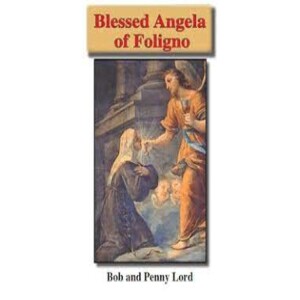
Monday Jan 08, 2024
Monday Jan 08, 2024
Stand In The Gap With Us And Saint Angela of Foligno "the Mistress 1/8/2024
She is sometimes called "the Mistress of Theologians." Her tomb is in the church of St. Francis in Foligno. Many miracles have been recorded there.
Born in Foligno on January 4, 1248 to a well-to-do family, she soon lost her father, and received little supervision from her mother. Thus, did she spend youth far from faith. Beautiful, intelligent, passionate, she married a notable local man, by whom she had several children.
Blessed Angela of Foligno was born in 1248 of a prominent family in Foligno, three leagues from Assisi.
Some saints show marks of holiness very early. Not Angela! Born of a leading family in Foligno, Italy, she became immersed in the quest for wealth and social position. As a wife and mother, she continued this life of distraction.
She was born on 21 March, 1474 in Desenzano, a small town on the shore of Lake Garda in Lombardy. When Angela was only 10 years old, she and her older sister became orphans. They went to live with their uncle in Salo, where they led a quiet and devout Catholic Christian life.
In her late 30s, she experienced a moral crisis. She had committed a sin so serious that she feared hell. She prayed through the intercession of St. Francis of Assisi, who had died some 60 years earlier, and he appeared to her in a dream promising he would render her aid. Soon after, Angela met a relative who was a Franciscan friar and priest. She made a full confession, did penance for her sins, and began to embrace Franciscan spirituality.
Around the age of 40, she recognized the emptiness of her life and sought God’s help in the Sacrament of Penance. Her Franciscan confessor helped Angela to seek God’s pardon for her previous life and to dedicate herself to prayer and the works of charity.
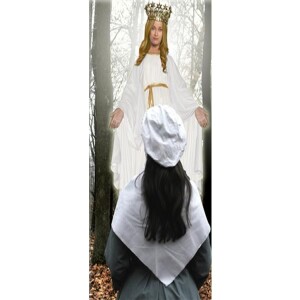
Monday Jan 08, 2024
Monday Jan 08, 2024
Join John Carpenter, Don Hartley, and the Deeper Truth research team as they review this miraculous series of incidents near Green Bay, Wisconsin from 1859- 1871.
In early October 1859, Adele reported seeing a woman clothed in white and standing between two trees, a hemlock and a maple. Adele described the woman as surrounded by a bright light, clothed in dazzling white with a yellow sash around her waist and a crown of stars above her flowing blond locks.
Adele Brise (Brice) was born in Belgium to Lambert and Catherine Brise on January 30, 1831. Although she suffered an accident at a young age that left her blind in her right eye, those who knew her best describe her cheerfulness, fervent piety, and simple religious ways.
Upon receiving her first Holy Communion, Adele and a few close friends promised the Blessed Virgin Mary that they would devote their lives to becoming religious teaching sisters in Belgium. However, this promise grew difficult to keep when her parents decided to move to America alongside other Belgium settlers. After seeking advice from her confessor, she was told to be obedient to her parents. He assured her that if the Lord willed her to become a teacher and a sister, she would serve in that vocation in America.
After the six-week voyage to America, the Brise family joined the largest Belgian settlement – near present-day Champion, Wisconsin. Belgian pioneers’ and settlers’ lives were difficult, and many died in the harsh Wisconsin winters. Adele served her family’s needs by often taking grain to the grist mill.
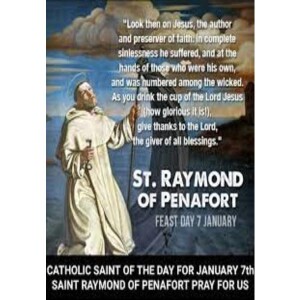
Sunday Jan 07, 2024
Sunday Jan 07, 2024
Stand In The Gap With Us And Saint Raymond of Penafort 1/7/2024
When looking at the lives of the Saints, it can be very interesting at how the Lord used the gifts of each person.
Although their gifts varied, they were sold out to God with all their hearts, minds, strengths, and souls.
They had many struggles as we all do, that is important to remember, but they are with the Lord.
We want to imitate their strengths and know their weaknesses to help inspire us.
It is also interesting how Jesus still uses the lives of the Saints for His glory. Chapter 4 of Revelation is relatively a small chapter, but there is a lot of meat and potatoes there giving us a glimpse of the worship taking place before the Throne of God.
There are the twenty-four thrones on which twenty-four elders sits wearing white robes crowned with glory. These thrones represents the twelve tribes of Israel and the twelve Apostles and their authority seats.
There are the four living creatures resembling the lion, a calf, a human face, and an eagle in flight exclaiming: “Holy, holy, holy is the Lord God almighty, who was, and who is, and who is to come (Revelation 4:8).”
Ezekiel was first given a vision of this (Ezekiel 1:5-21)who identifies them as cherubim angels (Ezekiel 10:20). These images represent what is noble, strongest, wisest, and swiftest in creation.
These images also are used by the Catholic Church to symbolize the evangelists Mark, Luke, Matthew, and John.
Notice the focus given the gospel readings at Mass! There is much more to this, but I want to touch upon the Holy Mass which benefits from this Heavenly worship taking place. The twenty-four Elders place their crowns before the Throne of God exclaiming, “Worthy are you, Lord our God, to receive glory and honor and power, for you created all things; because of your will they came to be and were created (Revelation 4:11).”
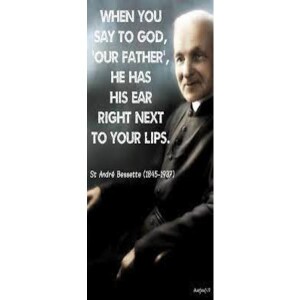
Saturday Jan 06, 2024
Saturday Jan 06, 2024
Stand In The Gap With Us And Saint Andre Bessette 1/6/2024
“My only ambition is to serve God in the most humble tasks.” Saint Andre Bessette
One of the benefits of being Catholic is the great access we have with the Kingdom of heaven.
Jesus gives this to everyone, but unfortunately, sadly some do not understand this very well.
Hebrews 12:1-2 states, “Therefore, since we are surrounded by so great a cloud of witnesses, let us rid ourselves of every burden and sin that clings to us and persevere in running the race that lies before us while keeping our eyes fixed on Jesus, the leader and perfecter of faith. For the sake of the joy that lay before him he endured the cross, despising its shame, and has taken his seat at the right of the throne of God”.
St. Andre Bessette saw this vision and now is among those within this cloud of glory. He is back on Deepertruth, what a joy to have the heavenly glory around us reminding us of our need to follow Jesus!
He was born in Quebec Canada raised in a small town called Mont-Saint-Gregore. He was so weak and frail, he was given an emergency Baptism.
My wife worked at a Catholic Hospital and has baptized infants just like this, which shows how sick he was at birth.
